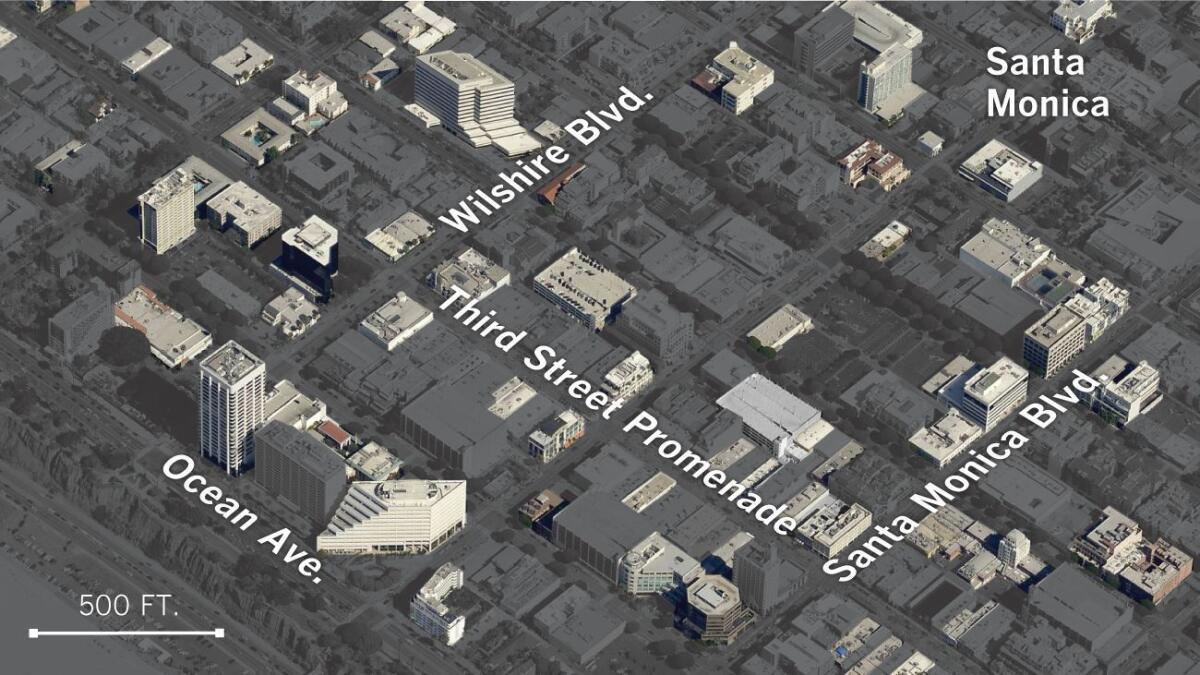Santa Monica adopts nation’s most extensive earthquake retrofit plan

- Share via
The Santa Monica City Council on Tuesday passed the nation’s most extensive seismic retrofitting effort, which will require safety improvements to as many as 2,000 buildings suspected to be vulnerable in an earthquake.
City leaders unanimously approved the ordinance in a second reading, which followed an initial vote in February. Property owners will begin receiving notices in May ordering them to conduct structural evaluations of buildings suspected to be at risk of damage in an earthquake.
“We want to do as much as we can to limit the loss of life and infrastructure, so in the event of a disaster, we bounce back strong,” Mayor Ted Winterer said in a statement.
The notices will be mailed out over the course of a year. The buildings included in the city’s list are commercial and multifamily residential buildings. Single-family homes are not included in the effort.
Buildings determined to be deficient would have to be strengthened.
Under the schedule outlined by city officials, about 200 brick buildings would need to be retrofitted within two years, and 30 concrete tilt-ups — made of poured concrete panels that are tilted into place to form the walls of a building, popular in erecting warehouses — would have three years to retrofit.
Wood apartments with flimsy ground stories, usually held up above first-floor carports by skinny columns that can snap during shaking, will have up to six years before their retrofit deadline passes.
Known as soft-story buildings, one such complex collapsed in the 1994 Northridge earthquake, killing 16 people on the ground floor in the predawn darkness. There are an estimated 1,700 soft-story buildings in Santa Monica.
Check if your building is on Santa Monica’s earthquake study list
Hover over the dots to see the address and the suspected type of building. Plug in a full address — such as 123 Spring Street, Santa Monica, CA — to zoom in on this map. Under a new law, structures listed will be required to undergo a seismic evaluation and a retrofit if necessary.
Roughly 70 suspected brittle concrete buildings will have a decade before a deadline to complete a retrofit, while an estimated 80 steel-frame buildings will have two decades.
So-called non-ductile concrete buildings lack sufficient steel reinforcing bars in their supporting columns, and shaking can cause them to disintegrate. Fifty-two people died in the collapse of several concrete buildings in the 1971 Sylmar earthquake.
In late 2015, Los Angeles passed its own major earthquake retrofit ordinance, requiring as many as 15,000 wood apartments and concrete buildings to be retrofitted. But Santa Monica’s law goes further in adding steel-frame buildings to the list of structure types subject to retrofitting.
Steel buildings were once considered by seismic experts to be among the safest. But after the 1994 Northridge earthquake, engineers were stunned to find that so-called steel moment frame buildings fractured.
In the Northridge earthquake, about 25 were significantly damaged. One — the Automobile Club of Southern California building in Santa Clarita, open for just 21 months — came very close to collapse, according to structural engineer Ronald Hamburger, senior principal with Simpson Gumpertz & Heger in San Francisco.
A year later, one story of a steel building collapsed during the 1995 Kobe earthquake in Japan.
The failure of even one high-rise could cause a large number of deaths.
The collapse of five high-rise steel buildings in Southern California was seen as possible during a future magnitude 7.8 earthquake on the San Andreas fault, according to the U.S. Geological Survey’s simulation of such a disaster. If the earthquake hit during working hours, about 5,000 people could be inside those five buildings.
Other building types fare worse — 50 brittle concrete buildings could collapse in such a temblor.
City officials estimate a cost of $5,000 to $10,000 per unit to retrofit a typical wood apartment building and $50 to $100 per square foot for concrete and steel buildings.
The city’s move comes more than three years after The Times reported how Santa Monica quietly stopped enforcing its earthquake safety regulations. The city had actually passed laws in the 1990s requiring retrofits of these buildings. But the mandatory retrofit effort quietly faded in the early 2000s amid the departure of key staff. By 2013, the city could not find its old list of possibly vulnerable buildings.
Former city officials were stunned when told of the missing list, and elected leaders vowed to take up the issue.
With the release of its list, Santa Monica has become the first city in California to publicly post a list of addresses of possibly vulnerable concrete and steel buildings that should be evaluated for seismic risk.
Los Angeles officials have already identified about 13,500 wood-frame buildings with a suspected weak first floor that officials suspect need repairs.
More to Read
Sign up for Essential California
The most important California stories and recommendations in your inbox every morning.
You may occasionally receive promotional content from the Los Angeles Times.











